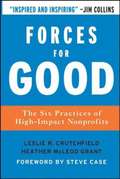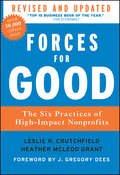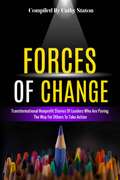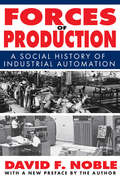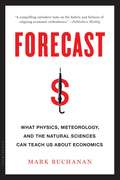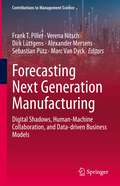- Table View
- List View
Forces for Good: The Six Practices of High-Impact Nonprofits
by Leslie Crutchfield Heather Mcleod GrantAn innovative guide to how great nonprofits achieve extraordinary social impact. What makes great nonprofits great? Authors Crutchfield and McLeod Grant searched for the answer over several years, employing a rigorous research methodology which derived from books on for-profits like Built to Last. They studied 12 nonprofits that have achieved extraordinary levels of impact-from Habitat for Humanity to the Heritage Foundation-and distilled six counter-intuitive practices that these organizations use to change the world. This book has lessons for all readers interested in creating significant social change, including nonprofit managers, donors and volunteers. Leslie R. Crutchfield (Washington, D.C.) is a managing director of Ashoka and research grantee of the Aspen Institute. Heather McLeod Grant (Palo Alto, CA) is a nonprofit consultant and advisor to Duke University's Center for the Advancement of Social Entrepreneurship and the Stanford Center for Social Innovation. Crutchfield and Grant were co-founding editors of Who Cares, a national magazine reaching 50,000 readers in circulation between 1993-2000.
Forces for Good: The Six Practices of High-Impact Nonprofits
by Heather Mcleod Grant Leslie R. Crutchfield J. Gregory DeesAn updated edition of a groundbreaking book on best practices for nonprofits What makes great nonprofits great? In the original book, authors Crutchfield and McLeod Grant employed a rigorous research methodology derived from for-profit books like Built to Last. They studied 12 nonprofits that have achieved extraordinary levels of impact--from Habitat for Humanity to the Heritage Foundation--and distilled six counterintuitive practices that these organizations use to change the world. Features a new introduction that explores the new context in which nonprofits operate and the consequences for these organizations Includes a new chapter on applying the Six Practices to small, local nonprofits, including some examples of these organizations Contains an update on the 12 organizations featured in the original book--how they have fared, what they've learned, and where they are now in their growth trajectory This book has lessons for all readers interested in creating significant social change, including nonprofit managers, donors, and volunteers.
Forces of Change: Transformational Nonprofit Stories of Leaders Who Are Paving the Way for Others To Take Action
by Cathy Staton Letitia Council Nadine Owens Nischelle Buffalow RonJeanna Harris Tanikwa Matthews Veronica McMillianForces of Change is a compilation of award-winning nonprofits started by ordinary people who create extraordinary change. Every story will show you how anyone can turn their biggest ambitions into reality. <p><p>If you feel inspired to start a nonprofit and seek direction, this book is for you. Driven by inspiring, life-changing stories and shareable insights, this is the book that will give you the tools to take action and make your impact in the world.
Forces of Labor: Workers' Movements and Globalization Since 1870 (Cambridge Studies in Comparative Politics)
by Beverly J. SilverRecasting labor studies in a long-term and global framework, the book draws on a major new database on world labor unrest to show how local labor movements have been related to world-scale political, economic, and social processes since the late nineteenth century. Through an in-depth empirical analysis of select global industries, the book demonstrates how the main locations of labor unrest have shifted from country to country together with shifts in the geographical location of production. It shows how the main sites of labor unrest have shifted over time together with the rise or decline of new leading sectors of capitalist development and demonstrates that labor movements have been deeply embedded (as both cause and effect) in world political dynamics. ,p>Over the history of the modern labor movement, the book isolates what is truly novel about the contemporary global crisis of labor movements. Arguing against the view that this is a terminal crisis, the book concludes by exploring the likely forms that emergent labor movements will take in the twenty-first century.
Forces of Order: Policing Modern Japan
by David H. BayleyPolice behavior in Japan and the United States
Forces of Production: A Social History of Industrial Automation
by David NobleFocusing on the design and implementation of computer-based automatic machine tools, David F. Noble challenges the idea that technology has a life of its own. Technology has been both a convenient scapegoat and a universal solution, serving to disarm critics, divert attention, depoliticize debate, and dismiss discussion of the fundamental antagonisms and inequalities that continue to beset America. This provocative study of the postwar automation of the American metal-working industry—the heart of a modern industrial economy—explains how dominant institutions like the great corporations, the universities, and the military, along with the ideology of modern engineering shape, the development of technology.Noble shows how the system of "numerical control," perfected at the Massachusetts Institute of Technology (MIT) and put into general industrial use, was chosen over competing systems for reasons other than the technical and economic superiority typically advanced by its promoters. Numerical control took shape at an MIT laboratory rather than in a manufacturing setting, and a market for the new technology was created, not by cost-minded producers, but instead by the U. S. Air Force. Competing methods, equally promising, were rejected because they left control of production in the hands of skilled workers, rather than in those of management or programmers.Noble demonstrates that engineering design is influenced by political, economic, managerial, and sociological considerations, while the deployment of equipment—illustrated by a detailed case history of a large General Electric plant in Massachusetts—can become entangled with such matters as labor classification, shop organization, managerial responsibility, and patterns of authority. In its examination of technology as a human, social process, Forces of Production is a path-breaking contribution to the understanding of this phenomenon in American society.
Forcibly Displaced: Toward a Development Approach Supporting Refugees, the Internally Displaced, and Their Hosts
by World BankThe Syrian refugee crisis has galvanized attention to one of the world’s foremost challenges: forced displacement. The total number of refugees and internally displaced persons, now at over 65 million, continues to grow as violent conflict spikes.This report, Forcibly Displaced: Toward a Development Approach Supporting Refugees, the Internally Displaced, and Their Hosts, produced in close partnership with the United Nations High Commissioner for Refugees (UNHCR), attempts to sort fact from fiction to better understand the scope of the challenge and encourage new thinking from a socioeconomic perspective. The report depicts the reality of forced displacement as a developing world crisis with implications for sustainable growth: 95 percent of the displaced live in developing countries and over half are in displacement for more than four years. To help the displaced, the report suggests ways to rebuild their lives with dignity through development support, focusing on their vulnerabilities such as loss of assets and lack of legal rights and opportunities. It also examines how to help host communities that need to manage the sudden arrival of large numbers of displaced people and that are under pressure to expand services, create jobs, and address long-standing development issues. Critical to this response is collective action. As work on a new Global Compact on Responsibility Sharing for Refugees progresses, the report underscores the importance of humanitarian and development communities working together in complementary ways to support countries throughout the crisis†•from strengthening resilience and preparedness at the onset to creating lasting solutions.
Ford Argentina: Transforming a Global Industry in a Local Market
by Lynda M. Applegate Ramiro Montealegre Paula Etchard Laureano BerasateguiThe president of Ford Argentina has to decide on the e-business approach at this subsidiary of Ford Motor Co. The approach must take into consideration the ambitious global e-business transformation proposed by the parent company within the context of a major economic crisis suffered in Argentina.
Ford Asia Pacific & Africa: The E-coating Facility Decision in Gujarat, India (A)
by Nancy Hua Dai Juan AlcacerIn April 2013, Ford Asia Pacific & Africa (FAPA) was examining its options for e-coating service metal parts for the Ford Customer Service Division in Sanand, Gujarat, India. Randy Creel, Director of Parts Supply & Logistics, FAPA, worked with his colleagues in the US, UK, China, and India to conduct analysis and develop three options: outsourcing e-coating to a third party in Sanand, outsourcing e-coating to a third-party in Chennai and transporting the parts to Sanand, or building a stand-alone facility in Sanand. Factors like cost, quality, speed, and risk needed to be considered for this decision which had impact on profitability and customer satisfaction. Which option should FAPA choose?
Ford Asia Pacific & Africa: The E-coating Facility Decision in Gujarat, India (B)
by Nancy Hua Dai Juan AlcacerThe case reveals that Ford decided to open its own e-coating plant in Gujarat, India, and details how the decision was made at different organizational levels.
Ford Motor Co.'s Value Enhancement Plan (A)
by Andre F. PeroldIn April 2000, Ford Motor Co. announced a shareholder Value Enhancement Plan (VEP) to significantly recapitalize the firm's ownership structure. Ford had accumulated $23 billion in cash reserves and under the VEP would return as much as $10 billion of this cash to shareholders. In exchange for each share currently held, the plan would give stockholders one new share plus the choice of receiving $20 in either cash or additional new Ford common shares. Shareholders electing to receive cash would be taxed on these distributions at capital gain rates. Among other things, the plan provided a means for the Ford family to obtain liquidity without having to dilute their 40% voting interest (even though they own only 5% of the shares outstanding). Students must wrestle with the following questions: Why was Ford proposing this transaction instead of a traditional share repurchase or a cash dividend? How did the interests of the Ford family factor into this decision, and what did the transaction imply about the future involvement of the family in the company? Why was Ford distributing such a significant amount of cash at this particular point in time? Did the distribution signal a change in the company's appetite for making acquisitions or future capital expenditures? If shareholders collectively elected to receive less than $10 billion in cash, how would Ford distribute the remaining cash?
Ford Motor Co.: Quality of Earnings Growth Analysis (A)
by Jacob Cohen David F. HawkinsEven though Ford Motor Co. reports improved profitability, an equity analyst issues a sell recommendation and Standard & Poor's downgrades long-term debt.
Ford Motor Co.: Supply Chain Strategy
by Robert D. AustinDescribes Ford's examination of its supply chain to evaluate whether the company should "virtually integrate" on the Dell Computers model.
Ford Motor Company: Blueprint for Mobility
by Marco Iansiti Karim R. Lakhani Noah FisherMark Fields, Ford Motor Company's COO, had to ensure the company's current business model of building cars and trucks remained strong, while concurrently navigating the company into the radily expanding industry of personal mobility. Personal mobility required new technologies and business models that were intraditional at Ford, and Fields had to evaluate the traditional business model colliding with the new business model. To direct these new technologies and business models, Ford released its "Blueprint for Mobility," which established near-, mid- and long-term goals to make mobility accessible and affordable to all. The case focuses on the launch of three mobility experiements (car sharing, parking, and on-deman ride sharing), and ask students to determine how Fields should balance these types of experiments with the company's traditional operations. Further, was Ford doing enough in the mobility space, and if so, was it moving fast enough? What new sources of revenue could Ford derive from mobility solutions?
Ford Motor Company: Strengthening the Dealer Network
by V. Kasturi Rangan Katharine Lee Marie BellThe case describes a five-year effort (2006-2011) of distribution rationalization and consolidation at Ford. The financial crisis in the second-half of 2008 forced GM and Chrysler into bankruptcy. Having completed the distribution overhaul work by 2011, its senior managers wondered how the transformed distribution channel would meet the needs of its new product strategy developed in response to the financial crisis.
Ford Motor Company: Strengthening the Dealer Network
by V. Kasturi Rangan Katharine Lee Marie BellThe case describes a five-year effort (2006-2011) of distribution rationalization and consolidation at Ford. The financial crisis in the second-half of 2008 forced GM and Chrysler into bankruptcy. Having completed the distribution overhaul work by 2011, its senior managers wondered how the transformed distribution channel would meet the needs of its new product strategy developed in response to the financial crisis.
Ford and the Global Strategies of Multinationals: The North American Auto Industry (Routledge Studies in International Business and the World Economy #23)
by Maria Isabel Studer NoguezToday, the Multinational Enterprise (MNE) is seen as a leading agent in the process of globalization. As they adopt global strategies, MNE's are seen to be creating stronger, deeper and more lasting links amongst countries, thus shifting the balance of power inexorably in their favour, to the detriment of the state.This book interrogates this idea by undertaking a historical analysis of the global strategies of Ford.
Ford vs. GM: The Evolution of Mass Production (A)
by Willy ShihThis case explores the very different paths taken by the Ford Motor Company and the General Motors Corporation in the first three decades of the twentieth century. Henry Ford's Model T was a car for the masses. After considerable experimentation, Ford Motor perfected a mass production system that converted the vast majority of jobs in the factory into routine tasks. It pioneered the moving assembly line, and it pursued processes that became increasingly integrated and mechanized. While it's single-minded focus on cost minimization led to spectacular market success for a time, the resulting inflexibility made it difficult for the company to respond to market changes. This created an opportunity for General Motors and others, particularly in the face of technological shifts to closed-body designs and metal stamping technology, as well as the marketing-led idea of the annual model change. The case offers a setting to examine several frameworks: exploration versus exploitation, the emergence of dominant designs, and vertical integration versus transaction costs and supplier hold-up. The A case closes with the question of what GM should do about supplier Fisher Body. The B case summarizes the shift to all-steel body stamping and engine manufacturing as the core technologies for automobile production, and how these changes made it difficult for Ford to maintain its first-mover advantage.
Ford vs. GM: The Evolution of Mass Production (B)
by Willy ShihThis case explores the very different paths taken by the Ford Motor Company and the General Motors Corporation in the first three decades of the twentieth century. Henry Ford's Model T was a car for the masses. After considerable experimentation, Ford Motor perfected a mass production system that converted the vast majority of jobs in the factory into routine tasks. It pioneered the moving assembly line, and it pursued processes that became increasingly integrated and mechanized. While it's single-minded focus on cost minimization led to spectacular market success for a time, the resulting inflexibility made it difficult for the company to respond to market changes. This created an opportunity for General Motors and others, particularly in the face of technological shifts to closed-body designs and metal stamping technology, as well as the marketing-led idea of the annual model change. The case offers a setting to examine several frameworks: exploration versus exploitation, the emergence of dominant designs, and vertical integration versus transaction costs and supplier hold-up. The (A) case closes with the question of what GM should do about supplier Fisher Body. The (B) case summarizes the shift to all-steel body stamping and engine manufacturing as the core technologies for automobile production, and how these changes made it difficult for Ford to maintain its first-mover advantage.
Fordlandia: The Rise and Fall of Henry Ford's Forgotten Jungle City
by Greg GrandinThe stunning, never before told story of the quixotic attempt to recreate small-town America in the heart of the Amazon In 1927, Henry Ford, the richest man in the world, bought a tract of land twice the size of Delaware in the Brazilian Amazon. His intention was to grow rubber, but the project rapidly evolved into a more ambitious bid to export America itself, along with its golf courses, ice-cream shops, bandstands, indoor plumbing, and Model Ts rolling down broad streets. Fordlandia, as the settlement was called, quickly became the site of an epic clash. On one side was the car magnate, lean, austere, the man who reduced industrial production to its simplest motions; on the other, the Amazon, lush, extravagant, the most complex ecological system on the planet. Ford's early success in imposing time clocks and square dances on the jungle soon collapsed, as indigenous workers, rejecting his midwestern Puritanism, turned the place into a ribald tropical boomtown. Fordlandia's eventual demise as a rubber plantation foreshadowed the practices that today are laying waste to the rain forest. More than a parable of one man's arrogant attempt to force his will on the natural world,Fordlandia depicts a desperate quest to salvage the bygone America that the Ford factory system did much to dispatch. As Greg Grandin shows in this gripping and mordantly observed history, Ford's great delusion was not that the Amazon could be tamed but that the forces of capitalism, once released, might yet be contained.
Forecast: What Physics, Meteorology, And The Natural Sciences Can Teach Us About Economics
by Mark BuchananPositive feedback--when A produces B, which in turn produces even more A--drives not only abrupt climate changes, but also the most important and disruptive events in economics and finance, from asset bubbles to debt crises, bank runs, even corporate corruption. But economists, with few exceptions, have ignored this reality for fifty years, holding onto the unreasonable belief in the wisdom of the market. It's past time to be asking how do markets really work? Can we replace economic magical thinking with a better means of predicting what the financial future holds, in order to prepare for, or even avoid the next extreme economic event? <P> In Forecast, physicist and acclaimed science writer Mark Buchanan answers these questions and more in building a new model for economics, one that accepts that markets act much like the weather does. While centuries of classical financial thought has trained us to understand "the market" as something that always returns to equilibrium, economies work more like our atmosphere--a loose surface balance riding on a deeper torrent of fluctuation. Market instability is as natural--and dangerous--as a prairie twister. With Buchanan's help, we can better govern the markets and weather their storms.
Forecasting Air Travel Demand: Looking at China (Routledge Advances in Risk Management)
by Shouyang Wang Kin Keung Lai Yafei ZhengThis book provides an updated, concise summary of forecasting air travel demand methodology. It looks at air travel demand forecasting research and attempts to outline the whole intellectual landscape of demand forecasting. It helps readers to understand the basic idea of TEI@I methodology used in forecasting air travel demand and how it is used in developing air travel demand forecasting methods. The book also discusses what to do when facing different forecasting problems making it a useful reference for business practitioners in the industry.
Forecasting Inflation in Sudan
by Kenji Moriyama Abdul NaseerA report from the International Monetary Fund.
Forecasting Next Generation Manufacturing: Digital Shadows, Human-Machine Collaboration, and Data-driven Business Models (Contributions to Management Science)
by Frank T. Piller Alexander Mertens Verena Nitsch Dirk Lüttgens Sebastian Pütz Marc Van DyckManufacturing companies have just begun to implement the concepts of the Fourth Industrial Revolution (Industry 4.0) on a larger scale. Still, this area is characterized by a rapid pace of technological change, blurring boundaries between physical, digital, and biological systems, and a quickly changing growing political, economic, and social environment -- leading to high uncertainty in decision making and many questions about the future development in this field. To provide guidance and inspiration for managers and academics on the future of digital manufacturing systems, this book presents the results of an extensive Delphi study on next-generation manufacturing systems, with a projection period of up to 2030. We analyzed almost 2000 quantitative estimations and more than 600 qualitative arguments from a large panel of industrial and academic experts from Europe, North America, and Asia. The book describes each of the 24 projections in detail, offering current case study examples and related research, as well as implications for policymakers, firms, and individuals. The empirical results also allowed us to build scenarios for the most probable future along the dimensions of governance, organization, capabilities, and interfaces from both a company-internal and an external (network) perspective.
Forecasting Time Series Data with Prophet: Build, improve, and optimize time series forecasting models using Meta's advanced forecasting tool, 2nd Edition
by Greg RaffertyCreate and improve fully automated forecasts for time series data with strong seasonal effects, holidays, and additional regressors using PythonPurchase of the print or Kindle book includes a free PDF eBookKey FeaturesExplore Prophet, the open source forecasting tool developed at Meta, to improve your forecastsCreate a forecast and run diagnostics to understand forecast qualityFine-tune models to achieve high performance and report this performance with concrete statisticsBook DescriptionProphet empowers Python and R developers to build scalable time series forecasts. This book will help you to implement Prophet's cutting-edge forecasting techniques to model future data with high accuracy using only a few lines of code.You'll begin by exploring the evolution of time series forecasting, from basic early models to present-day advanced models. After the initial installation and setup, you'll take a deep dive into the mathematics and theory behind Prophet. You'll then cover advanced features such as visualizing your forecasts, adding holidays and trend changepoints, and handling outliers. You'll use the Fourier series to model seasonality, learn how to choose between an additive and multiplicative model, and understand when to modify each model parameter. This updated edition has a new section on modeling shocks such as COVID. Later on in the book you'll see how to optimize more complicated models with hyperparameter tuning and by adding additional regressors to the model. Finally, you'll learn how to run diagnostics to evaluate the performance of your models and discover useful features when running Prophet in production environments.By the end of this book, you'll be able to take a raw time series dataset and build advanced and accurate forecasting models with concise, understandable, and repeatable code.What you will learnUnderstand the mathematics behind Prophet's modelsBuild practical forecasting models from real datasets using PythonUnderstand the different modes of growth that time series often exhibitDiscover how to identify and deal with outliers in time series dataFind out how to control uncertainty intervals to provide percent confidence in your forecastsProductionalize your Prophet models to scale your work faster and more efficientlyWho this book is forThis book is for business managers, data scientists, data analysts, machine learning engineers, and software engineers who want to build time-series forecasts in Python or R. To get the most out of this book, you should have a basic understanding of time series data and be able to differentiate it from other types of data. Basic knowledge of forecasting techniques is a plus.
